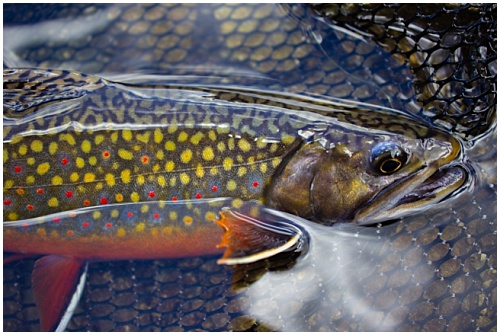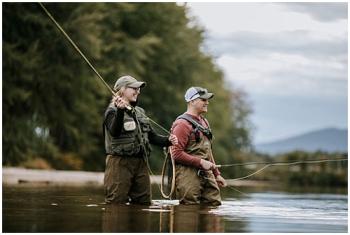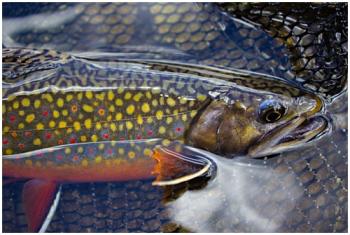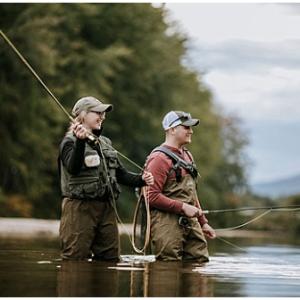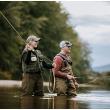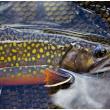30 ways to help conserve Maine’s fisheries
Our beautiful state is turning 200 this year! But Maine wouldn’t be “Maine” without our fish, wildlife, and recreation opportunities. Celebrate with us by learning 200 ways YOU can help conserve Maine for generations to come.
Here are 30 ways you can help conserve Maine’s fisheries from the Maine Department of Inland Fisheries and Wildlife:
1. Introduce someone new to fishing and teach them how to be an ethical, responsible angler.
2. Properly dispose of or recycle used tackle and fishing gear. Never throw it in the water.
3. Purchase a Maine Sportsman License Plate. These funds help support Maine’s fish hatcheries (50%), endangered species conservation (10%), a stronger landowner relations program (25%); and develops boat launches for public access to Maine’s inland waterways (15%).
4. Always check the current fishing laws before trying a new body of water. The new Maine Fishing Laws Online Angling Tool is a great way to learn about regulations for a specific water body.
5. Inspect your soft plastic bait frequently. After catching a fish, make sure your bait is still intact. If your bait is worn and will likely fall off, replace it with a new bait, re-hook it, or repair it.
6. Dispose of unused baitfish on land or in the trash. Do not release any baitfish (dead or alive) into a water body.
7. If the fish is within the legal limit, do not be afraid to harvest your catch. Anglers sometimes believe catch and release is the best way to improve a fishery. However, many fishing regulations are designed to improve fish growth and size quality, and they are only successful if fish are harvested by anglers.
8. Inspect your boat for invasive aquatic plant and animal species and practice Clean, Drain, Dry techniques.
9. Don’t assume a dry plant is dead—some invasive plants can dry out while on equipment, re-saturate when exposed again to water, and survive to spread in the next body of water they enter.
10. Learn how to identify baitfish so you can make sure you’re using legal baitfish.
11. If you are an avid angler and are interested in sharing your fishing data, contact your local regional headquarters and speak to a fisheries biologist about our voluntary booklet keeper program.
12. Follow bag limits, bait restrictions, and other regulations. These important regulations protect native resources, enhance fishing quality, maintain healthy ecosystems, control exotic species in certain waters, meet public safety needs, and balance social desires.
13. Buy a fishing license, even if you don’t plan to fish, to help support fisheries management and conservation right here in Maine.
14. Buy new fishing gear! There is a manufacturer-paid excise tax on fishing equipment which goes into a special fund that is distributed by the U.S. Fish and Wildlife Service (USFWS). The funds are used here in Maine to help develop water access sites, conserve fisheries, special restoration projects, and more. Learn more.
15. Immediately kill any sport fish that you decide to keep. Keeping sport fish alive such as in a live well is illegal (unless one is participating in a bass tournament).
16. Never introduce any fish into Maine waters, it can alter the ecosystem forever and is illegal. This includes aquarium fish and plants. And remember, it is illegal to import any freshwater fish into the state of Maine without a permit from the Maine Department of Inland Fisheries and Wildlife.
17. Download the lawbook to your phone so you always have it with you.
18. Learn how to properly care for your catch to improve the quality and taste, which makes harvesting fish a better experience. See page 43 of the Fishing Guide for recommendations.
19. If you are using chemicals to clean your boat, make sure you do it when the boat is out of the water and rinse thoroughly.
20. Ensure your boat and other equipment are properly maintained so they are not leaking potentially harmful fluids into the water.
21. Visit a fish hatchery to learn about Maine’s fish stocking program. Click here for fish hatchery hours and locations (please call ahead before you visit).
Anglers have the choice to keep or to release their catch, as long as the fish is within the legal limit and they aren’t fishing in a catch-and-release-only water body. Remember from #7 that catching and releasing isn’t always the best way to improve fish size and the population. Many fishing regulations are designed to improve fish growth and size quality, and they are only successful if fish are harvested by anglers. If you are releasing a fish, please carefully follow the instructions below to help ensure the fish is unharmed:
22. Time is of the essence. Play and release the fish as quickly and carefully as possible. An exhausted fish may be too weak to recover.
23. Keep the fish in the water. Minimize or eliminate the time your fish is out of the water. As little as 30 seconds of air exposure can cause delayed mortality of released trout, and in the winter months the fish may be subject to a quick freeze.
24. Wet your hands when handling the fish. Dry hands can remove the layer of slime that protects the fish from fungi, bacteria, and parasites.
25. Photograph responsibly. Photo sessions can be stressful for a fish. Prepare for the photo with your fish safely under the water surface, and only lift the fish out of the water for 5 second intervals or less. Try to get the shot (within reason), but return your fish to the water for a rest between attempts.
26. Be gentle. Keep your fingers away from the gills, don’t squeeze the fish, and please, never drag a fish onto the bank!
27. Choose the right landing net. Rubber nets are easier on fish than traditional twine nets (and they help prevent hook tangles too!).
28. Safely remove the hook with small pliers or a similar tool. If the hook is deeply embedded or in a sensitive area such as the gills or stomach, cut the leader close to the snout.
29. Neutralize the pressure. The air bladders of togue (lake trout) often expand after being pulled up rapidly from deep water. If a togue’s belly appears expanded, release it from the hook first, then while holding it in the water, gently press your thumb along the stomach near the paired belly fins and move it forward a few times to release the air before releasing the fish.
30. Revive the fish. Hold the fish underwater in a swimming position until it can swim away (note: do not use this method if surface water temperatures are unusually warm).
Event Date
Address
United States


